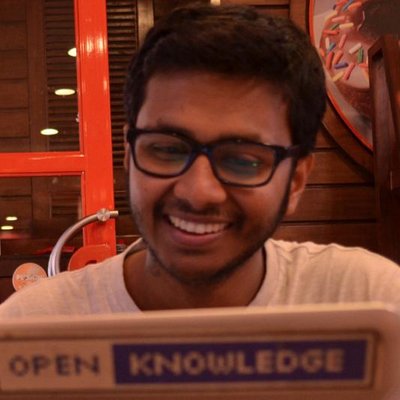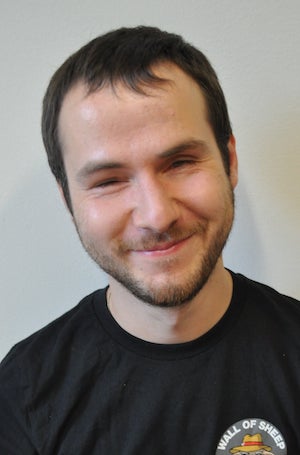optical character recognition (OCR)
See the following -
6 Ways to Use Open Tools to Better Support Indian Languages
 India is a large and a populated country that makes up a large base of Google consumers. So in recent years, Google's widened support of world languages for its various products has been a blessing. It has specifically helped Indian people grow their use of and participation on the Internet. For one, Google Summer of Code helps students experiment with and build prototypes that enhance language-based software. Another way is through Google Translate, a web and app-based platform that provides machine translation from one language to another. It is predominantly maintained and serviced by volunteer contributionss...
India is a large and a populated country that makes up a large base of Google consumers. So in recent years, Google's widened support of world languages for its various products has been a blessing. It has specifically helped Indian people grow their use of and participation on the Internet. For one, Google Summer of Code helps students experiment with and build prototypes that enhance language-based software. Another way is through Google Translate, a web and app-based platform that provides machine translation from one language to another. It is predominantly maintained and serviced by volunteer contributionss...
- Login to post comments
Fax Technology is the Cornerstone of Interoperability. Here's Why.
 Fax is the dominant information exchange technology in U.S. healthcare, outpacing secure direct messaging 25-to-1. Most of that is exchanged using inefficient and unsecure machines. With the emergence of cloud-based fax technology to facilitate secure system-to-system document transfer, the use of cloud fax needs to be part of every CTO's/CIO's digital strategy...The evolution of fax from paper-based to cloud transmission and storage - Cloud Fax Technology (CFT) - is a key step that enables providers to comply with HIPAA and other regulations. Further strengthening CFT as a key component in Healthcare Information Systems (HIS) is its evolution into Direct Messaging platforms, enabling the seamless exchange of Patient Health Information (PHI) between the diverse data and document management systems used by labs, pharmacies, doctor's offices, hospitals, and billing providers. CFT supports and contributes to the goal of interoperability...
Fax is the dominant information exchange technology in U.S. healthcare, outpacing secure direct messaging 25-to-1. Most of that is exchanged using inefficient and unsecure machines. With the emergence of cloud-based fax technology to facilitate secure system-to-system document transfer, the use of cloud fax needs to be part of every CTO's/CIO's digital strategy...The evolution of fax from paper-based to cloud transmission and storage - Cloud Fax Technology (CFT) - is a key step that enables providers to comply with HIPAA and other regulations. Further strengthening CFT as a key component in Healthcare Information Systems (HIS) is its evolution into Direct Messaging platforms, enabling the seamless exchange of Patient Health Information (PHI) between the diverse data and document management systems used by labs, pharmacies, doctor's offices, hospitals, and billing providers. CFT supports and contributes to the goal of interoperability...
- Login to post comments
Open Source Software Creeps into Healthcare through Clinical Research
 Although open source has not conquered the lucrative market for electronic health records (EHRs) used by hospital systems and increasingly by doctors, it is making strides in many other important areas of health care. One example is clinical research, as evidenced by OpenClinica in field of Electronic Data Capture (EDC) and LabKey for data integration. Last week I attended a conference for people who use OpenClinica in their research or want to make their software work with it. At any one time, hundreds of thousands of clinical trials are going on around the world, many listed on an FDA site. Many are low-budget and would be reduced to using Excel spreadsheets to store data if they didn’t have the Community edition of OpenClinica. Read More »
Although open source has not conquered the lucrative market for electronic health records (EHRs) used by hospital systems and increasingly by doctors, it is making strides in many other important areas of health care. One example is clinical research, as evidenced by OpenClinica in field of Electronic Data Capture (EDC) and LabKey for data integration. Last week I attended a conference for people who use OpenClinica in their research or want to make their software work with it. At any one time, hundreds of thousands of clinical trials are going on around the world, many listed on an FDA site. Many are low-budget and would be reduced to using Excel spreadsheets to store data if they didn’t have the Community edition of OpenClinica. Read More »
Open-Source Tool Enables Vendor-Neutral CT Does Archiving
Researchers in Boston have developed an automated radiation-exposure monitoring system that extracts detailed CT exposure data from image repositories. Thanks to optical character recognition (OCR) software, the open-source software scheme can gather data from virtually any CT scanner model, even older ones without DICOM-based dose displays. Read More »
- Login to post comments
OpenFDA Backstory: Breaking The Paperwork Backlog
The startup Captricity uses a combination of crowdsourcing and OCR to digitize mountains of paper records, particularly for government agencies and healthcare. Read More »
- Login to post comments
Remixing Linux For Blind And Visually Impaired Users
 When I was around 5 years old, my father brought home our first computer. From that moment on, I knew I wanted to pursue a career in computers. I haven't stopped hanging around them since. During high school, when considering which specific area I wanted to focus on, I started experimenting with hacking, and that was the moment I decided to pursue a career as a security engineer. I'm now a software engineer on the security compliance team. I've been at Red Hat for over two years, and I work remotely in the Czech Republic. Outside of my day job, I play blind football, and I'm involved in various projects connecting visually impaired and sighted people together, including working in a small NGO that runs activities for blind and visually impaired people. I'm also working on an accessible Fedora project currently called Fegora, an unofficial Linux distribution aimed at visually impaired users.
When I was around 5 years old, my father brought home our first computer. From that moment on, I knew I wanted to pursue a career in computers. I haven't stopped hanging around them since. During high school, when considering which specific area I wanted to focus on, I started experimenting with hacking, and that was the moment I decided to pursue a career as a security engineer. I'm now a software engineer on the security compliance team. I've been at Red Hat for over two years, and I work remotely in the Czech Republic. Outside of my day job, I play blind football, and I'm involved in various projects connecting visually impaired and sighted people together, including working in a small NGO that runs activities for blind and visually impaired people. I'm also working on an accessible Fedora project currently called Fegora, an unofficial Linux distribution aimed at visually impaired users.
- Login to post comments